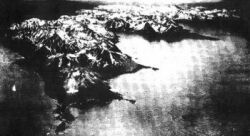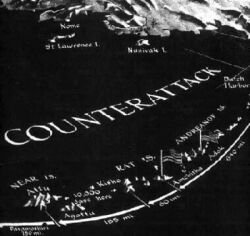|
Like a giant causeway over the wastes of the North Pacific, the Aleutians
stretch about 1,000 miles from the Alaskan mainland. On to windswept,
fog-washed Attu at their western tip, American troops swarmed last week.
The Job: In attacking Attu, the Army & Navy simply cut around the
Jap forces on strongly held Kiska, presumably proposed to deal with them
later or to starve them out. Although the Japs apparently had a relatively
small force on Attu, they had a strong position. Only 35 miles long and
20 miles wide, Attu is fiercely rugged. Its swampy beaches offer no
natural cover, few places for landings. The Japs would have to be blasted
from every rock and shelter.
The Objective: Occupation of Attu will give the US a bomber strip
which the Japs recently built (but apparently have never been able to use
in the foul Aleutian weather). That strip, when & if it can be used,
places the Jap naval base at Paramoshiri, 750 miles to the west of the
Northern tip of the Kurile Islands, within easy reach of US bombers.
Established there, US fighting men would be only 650 miles from Hokkaido,
top-most of the main Japanese islands.
But, for the moment, the main purpose of the Aleutian campaign was probably
to drive the Japs back from the North American reaches, where they have
been perched since June 3rd. The long-term possibilities of Aleutian
bases, always limited by weather and isolation, can be realized only when
world strategy permits all-out attack on Japan.
On Kiska, now between Americans on Attu and Americans on Amchitka, the
Japs have a fighter strip, several thousand bomb-harried troops, a seaplane
base, and a haven for submarines. The Japs'
General Baron Sadao Araki was
not sanguine. Said he; "Setbacks there and at home will only increase our
strength...."
|

